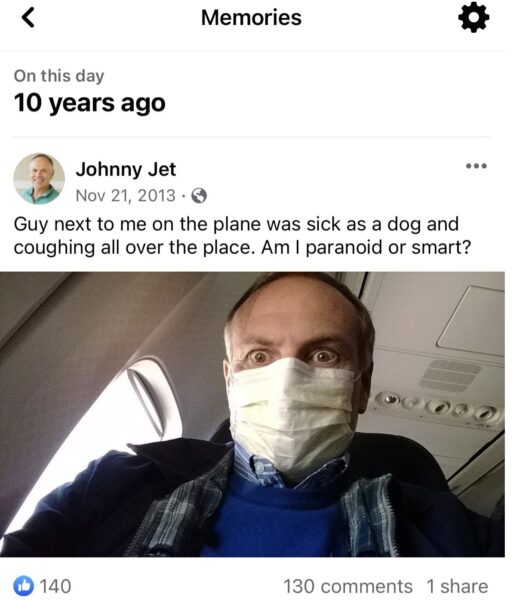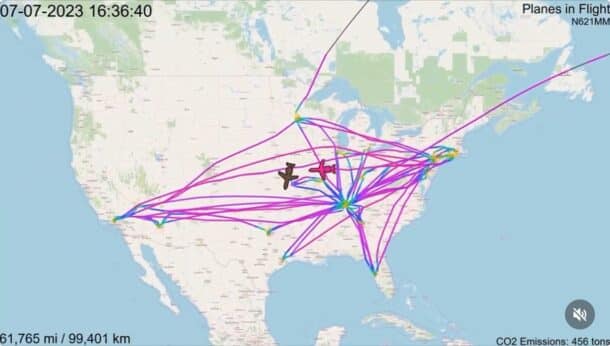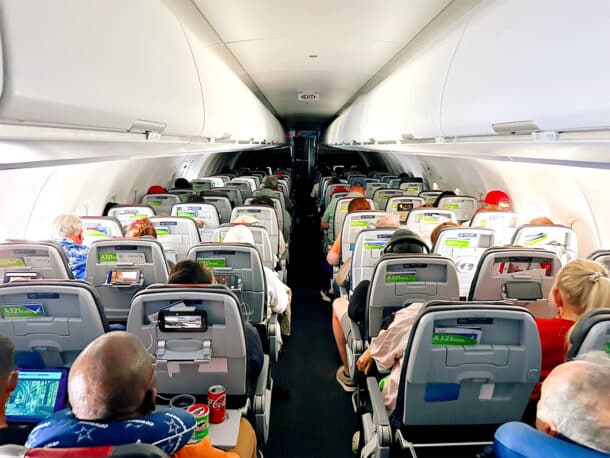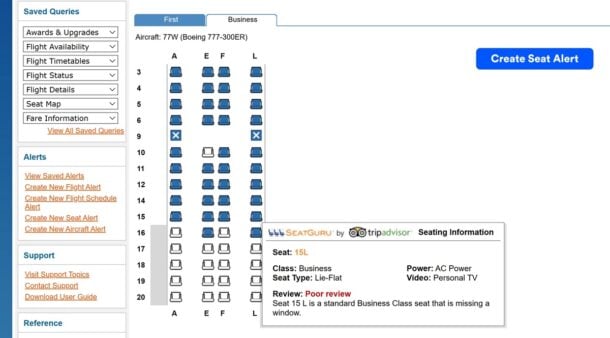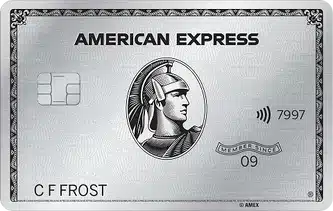Shalom from Israel! Last week, we left off after our El Al flight touched down in Tel Aviv. This week, we hit Jerusalem. If you thought that Israel was unsafe and only for Jews (like I did), think again.
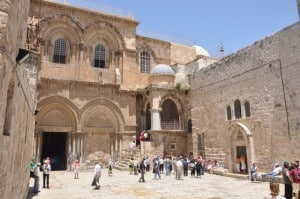 ISRAEL
ISRAEL
I’ve always been fascinated by Israel and for years I’ve wanted to visit. But like most of my friends, I was worried about many things, namely my safety. As you will see, all of my fears quickly disappeared once I arrived and I was pleasantly surprised.
SAFETY
First of all, let’s clear the air about the most important concern: safety. Every time I told my non-traveling friends or family members I was heading to Israel, they looked at me like I was crazy, followed by, “Be very careful.” I then sought advice from my experienced, well-educated traveling friends and family members, which was when I realized I had “nothing to fear but fear itself.” Most of them convinced me that Israel is safer than America in some ways. Someone went on to tell me that Israel is so safe that kids go to school on their own there; later, I saw a bunch of six-year-olds walking by themselves on their way to school, to prove that point. I guess all those images on T.V. of war and unrest is similar to when there are forest fires, landslides or earthquakes in California. My East Coast friends all call me to ask if my house is on fire, sliding down a hill or in shambles. And I say: “No – I’m not near any of those places and if it wasn’t for you calling me, I wouldn’t have even known.” Like in Israel, those disasters take place in certain areas – not the whole country. Lesson learned: don’t believe everything you see or hear on the news.
AIRPORT TO JERUSALEM
At the Ben Gurion International Airport, Natalie and I met our guide, Amir (e-mail: or-ly@inter.net.il or Tel: 011 972 523 806 800) and driver Eitan, who were one of the best duos I’ve ever had. They were arranged through the Israel tourism office and Amir usually tours around high profile celebrities or dignitaries, so we got lucky. The drive from the Tel Aviv airport to Jerusalem is about 35 minutes and along the way, Amir educated us with some fast facts: 1. The currency is New Israel Shekels (NIS) and the current exchange rate is 1.00 NIS = $0.26 USD or $1 USD = 3.75 NIS. 2. All Israelis are not Hasidic Jews – only a very small percentage (about 7%) 3. Israel has a land area of 8,522 square miles, which is slightly smaller than the state of New Jersey (8,722 sq miles) 4. Israel has an approximate population of 7.4 million. Only 75.5% are Jewish 5. Hebrew and Arabic are the official languages. However, English is widely spoken. 6. All the street signs are tri-lingual: Hebrew, Arabic and English 7. Friday sundown to Saturday sundown is Sabbath or Shabbat, which means “cease” or “rest”. So this is primarily a day of rest and spiritual enrichment.
FIRST STOP
We landed in morning and Amir suggested we stop at a Joe’s Office Café along the way for a snack and map out our week’s plan. Natalie ordered a NY Bagel with cream cheese, jam and tea/coffee (25 NIS). I had vanilla yogurt with granola and fruit (25 NIS). It was good but I felt more like I was in California than the Middle East.
JERUSALEM
Next stop: Gerald Halbert Park and Observation Plaza to see the contrast of the country. On one side is a lot of life and on the other – there’s nothing but the desert and the Dead Sea and Jordan off in the distance. We hopped back in the car and drove a short distance to the Mount of Olives, which took us through an Arab town … that surprised me too.
REHAV’AM LOOKOUT
We were at the Rehav’am Lookout, which peeks over the old city of Jerusalem. This is tourist central because it’s the perfect place to begin the walking tour. I tried to listen to Amir as he told us some of the history but I couldn’t concentrate. All I could do was remind myself I wasn’t dreaming. I kept my eyes wide open wide and just tried to soak it in where I was actually sitting. It’s the same backdrop many news agencies use.
DONKEY PHOTO OP
Natalie and I were so excited that we didn’t even go to the hotel to drop off our bags or take a shower. We just went straight to see some of the holiest Christian sites in the world. We also had a photo op with a friendly Arab and his donkey; the guy was so nice he kissed the palm of his hand before shaking mine. Of course, I had to cleanse it later with Purell.
DOMINUS FLEVIT CHURCH
We started off visiting Dominus Flevit Church, which is in the shape of a teardrop to symbolize the tears of Christ. This was believed to be the spot (according to Luke 19:37-42) where Jesus, while walking toward the city of Jerusalem, became overwhelmed by the beauty of the Second Temple and predicted its future destruction. More info on Dominus Flevit Church
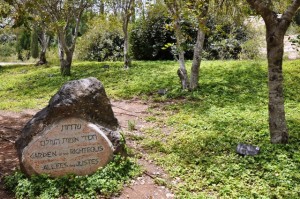 GARDEN OF GETHSEMANE
GARDEN OF GETHSEMANE
We continued down the slippery hill, admiring the ancient gravesites until we reached the Garden of Gethsemane. According to Luke 22:43–44 this is where Jesus was arrested as he and his disciples prayed, the night before his crucifixion.
NOTE: According to the Eastern Orthodox Church tradition, this is where the Apostles buried the Virgin Mary. More info on Gethsemane.
CHURCH OF ALL NATIONS
Attached to the Garden, which by the way is full of beautiful flowers and some of the oldest olive trees on earth, is the Church of All Nations. According to Mark 14:32-42, it enshrines a section of bedrock where Jesus is said to have prayed before his arrest. Inside, a private Polish mass was taking place and tour groups from all over the world were passing through admiring the mosaic floor. More info on The Chruch of All Nations.
JERUSALEM BAGEL
We then drove maybe a mile to the Ophel Archaelogical Park and the Davidson Center – it’s where the Wailing Wall is. Outside, I got my first view of the Jerusalem bagel – they are about four times the size of New York bagels and are much cheaper (you can get them for 5 NIS or less). They come with sesame seeds on them but be sure to get a side of hyssop. It’s like oregano and you dip the bread in it. Oh, is it tasty!
WESTERN WALL
The Western Wall, also referred to as the Wailing Wall or Kotel, is one of, if not the, most important Jewish religious site in the world. It’s located in the Old City of Jerusalem and is open 24 hours (free admission). It dates from the end of the Second Temple period and was constructed around 19 BCE by Herod the Great. The wall is 187 feet (57 m) high and stretches for 1,600 feet (488 m). All religions are welcome but there are separate sections for men and women. Men need to either wear a hat or borrow a free paper kipa (which means dome) to cover their head if they intend to go up to the wall. Women must cover their shoulders and knees. More info on The Western Wall.
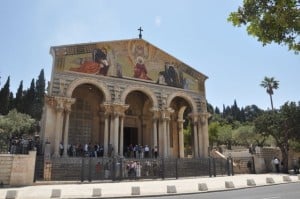 PRAYING ON THE WALL
PRAYING ON THE WALL
Those who go up to the wall to pray, stick a piece of paper with their prayer on it, into one of the crevices in the wall. I was trying to find a spot for mine and in the process, I accidently knocked about 10 pieces of paper out. My heart stopped and at the same time an old man (a Hasidic Jew, dressed to the nines) grabbed my hand – I thought it was over. He didn’t speak much English but he said, “It’s okay. Let’s pray.” Suddenly, I was praying with him against the wall … and then he asks me for money. I got suckered – but I gave him a U.S. dollar and he was happy.
VIA DOLOROSA
A short walk from the wall is Via Dolorosa. It’s the route Jesus walked, carrying the cross on his back. Back then it was just a dirt path but today it’s an Arab souk (bazaar). Each station is marked and the last, which was the site of Christ’s crucifixion and burial, is at Church of the Holy Sepulchre. More on the Church of the Holy Sepulchre.
CHURCH OF THE HOLY SEPULCHRE
The Pope was giving mass inside the Church of the Holy Sepulchre so security wouldn’t let people within a few hundred yards radius, maybe more. However, Amir had us slip in with a bunch of monks and photographers and we walked with them through places we weren’t supposed to be. Then Amir took a sudden right turn down a deserted alley and while following reluctantly, I whispered, “Amir, they’re all going the other way.” Barely moving his lips, he whispered back, “Trust me and just pretend you own the place.” We walked right by a ton of police and military and ended up on top of the church! He opened one of the doors and there it was – The Rotunda of the Anastasis of which is the Edicule of the Holy Sepulchre itself.
INSIDE THE CHURCH
Mass had just ended and we quickly made our way down there to have the place basically to ourselves; there were maybe seven other tourists. The church is run by the Eastern Orthodox, Roman Catholic and Armenian Apostolic churches – that was true of a few of the churches that I visited. At the entrance is the Stone of Anointing where I laid my hands like everyone else and felt some kind of crazy energy. The day before, it was a few minutes’ wait to do just that – and an hour wait to get into the rooms holding The Angel’s Stone, a fragment of the stone believed to have sealed the tomb after Jesus’ burial and the tomb itself. I lit some candles for my mom and loved ones and left with a huge smile on my face. It wasn’t only the highlight of the trip but possibly the highlight of a lifetime. More info on The Church of Holy Sepulchre.
LAST SUPPER & DORMITION ABBEY
There are so many holy sites in Jerusalem that I could write a book so instead I recommend buying a guidebook. I used Frommer’s Israel like I do for pretty much everywhere I go. In the interest of full disclosure, you should know I write for them, too. Other highlights included the site of the Last Supper, which is not in its original building (obviously) but rather the place is said to be the exact spot where it happened. Below is King David’s Tomb and nearby is Dormition Abbey, the place where the Virgin Mary fell asleep. More info on The Last Supper Room.
CARDO MAXIMUS
We walked all around and Amir took me to Cardo Maximus. It was a Roman road built during the reign of the emperor Justinian (527-565). Most of it hasn’t been uncovered since it’s situated 20 feet below the street level. The two main parts that have been uncovered are part open-air reconstructed street; the other part is a restored arcade of Jewish galleries and shops. More info on Jerusalem’s Cardo.
YAD VASHEM
The last place that is a must visit is Yad VaShem, which figuratively means a monument and a memorial. This new Holocaust museum opened in 2005 as the Jewish people’s living memorial to the Holocaust. I got emotional just walking the “Avenue of the Righteous Among the Nations”, which is between the parking lot and the modern building. Visitors pass trees that are planted in tribute to each individual gentile who helped save Jewish lives during the Nazi era like Anne Frank, Oskar and Emilie Schindler. The building itself hangs on a cliff symbolizing that the Jews of Europe had the writing on the wall and it is amazingly shaped. As you enter and follow the narrow zigzagging path to the maze of galleries, you go downhill. There’s a black and white video on the wall at the entrance, depicting the good times of the Jews in Europe but then, as we all know, things gradually get worse. I saw images and read stories that had a profound effect on me, an effect that will certainly last the rest of my life. But the museum does present a happy ending; visitors are shown progression as the path gradually inclines. It represents when the war is over and the exit has a view of the city, which is just breathtaking. More info on Yad Vashem.
RESPECT FOR GERMANY
Amir said only three countries honor the Holocaust – Israel, The U.S. and Germany (I visited the Holocaust Museum in Berlin last year) and Amir said the Germans should get a lot of credit for that. In fact, you would think there would be huge animosity towards the Germans but there didn’t seem to be at all. In fact, the van we had, which is owned by the Israeli tourism board, was a Volkswagen.
BIRTH RITE PROGRAM
Did you know that if you are of Jewish descent and between the ages of 18 to 26 you can apply for a free 10-day trip to Israel? It’s called the Birth Rite program and over 220,000 young adults have taken advantage of it since it was started 10+ years ago. Here’s a link with more information.
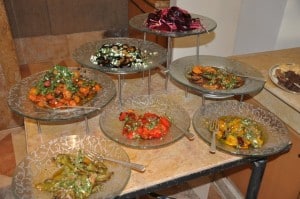 MEZE DINNER
MEZE DINNER
The first night, we had dinner at a tasty Arab-Israeli restaurant called Minaret. They serve meze so we had 18 small plates of falafel, tahini, eggplant, pickles, hummus, red cabbage. Then came chicken, lamb and beef kebobs with French fries and rice. The whole thing cost $20 USD per person. Minaret Restaurant, 18 Shlomzion Hamalks Street, Tel: 02-6234470.
DAVID CITADEL HOTEL
In Jerusalem we stayed at the 384-room David Citadel Hotel. It’s located in the Western part of the city and is one of the three best hotels in the city. I quickly learned that Israeli hotels are among the most secure in the world. Typically there’s only one entrance/exit, which has a guard doing security checks. For us, they just checked to see if our name was on the registration list and our bags went through a separate door for x-ray screening. The David Citadel Hotel, 7 King David Street, Jerusalem, 94101, Tel: +972 2 621 1111.
OUR ROOM
The hotel’s decor is grand. The vast marble lobby is impressive with its sweeping staircases and snaking hallways. The rooms are a good size and have a fairly comfortable bed. There’s a flat screen TV, two phones, mosaic artwork, a stylish marble tan bathroom with a separate shower and tub stocked with L’Occitane products. Wi-fi Internet is available, which worked for free for the first day but the second day, required a code which needs to be purchased from the front desk for 65 NIS.
NEGATIVES
The only negatives were: a) the evil mini bar which charges you instantly if you remove something; b) they don’t recycle towels and the walls are super thin. We actually had to move because I could hear our neighbor sneezing and talking on the phone like she was in our room.
TIP: Request a room without a connecting door and that should help.
DINING
The hotel has five restaurants: The Seasons, Yakimonotoo, The Pool Grill, the Lobby & Terrace restaurant and Scala Restaurant. One night I had dinner with travel writer Buzzy Gordon at Scala, which serves upscale Mediterranean food. I had cream of bean soup, with lentils and a quail egg, then chicken with sweet potatoes and dates. One late Friday night, after missing the hotel’s incredible Shabat dinner, (300 NIS per person), Natalie and I ate at the Terrace restaurant which overlooks the pool, domes, steeples and towers of the ancient walled city of Jerusalem.
ISRAELI BREAKFAST
Our favorite meal was at Seasons for the breakfast buffet. Oh my God! My friends had told me about the incredible Israeli breakfasts and I thought they were exaggerating. Wow, do these guys know how to eat breakfast! They serve a variety of hot dishes, fresh salads, fruits, vegetables, local cheeses, cereal, yogurt, breads, cakes and smoked fish and herring. I went to town each morning and the service was amazing. However, the crew at the front door is just okay, maybe because they are mostly there for safety.
LOCATION
The hotel’s location is fantastic. It’s right across the way from the Old City and the brand new Alrov Mamilla pedestrian mall, which is loaded with shops and cafes. One afternoon we ate at Roladin Bakery & Cafe and I had sweet potato ravioli (48 NIS) while Natalie enjoyed a huge Tuna sandwich, which came with a fresh salad (36 NIS).
BUDGET ACCOMMODATIONS
If I’d been paying my way, I would have booked at room at the YMCA, which is across from Jerusalem’s most prestigious hotel, the King David Hotel. Most every head of state and celebrity that has visited Jerusalem has stayed there but for three to five times less the price, the almost equally impressive YMCA is across the street and can be yours for $120 USD/single or $145/double a night. It also has a restaurant that’s open on the Sabbath. Jerusalem YMCA & The King David websites.
FYI: It cost 10 shekels to send a postcard to North America from Israel.
NEXT WEEK
Next week: The Dead Sea, Masada and Bethlehem!
Web Resources
- The David Citadel Hotel
- Jerusalem YMCA
- The King David
- Jerusalem Weather
- Israel Festivals
- Israel Tourism
- Greeting and Saying Good-bye in Hebrew
- Israel Post
- Relics of Israel
- JohnnyJet.com
- Johnny’s Twitter
- Johnny’s Facebook
- My Blog
- Newsletter Archive
- AirlineNumbers.com
- HotelNumbers.com
- AlternateAirports.com


